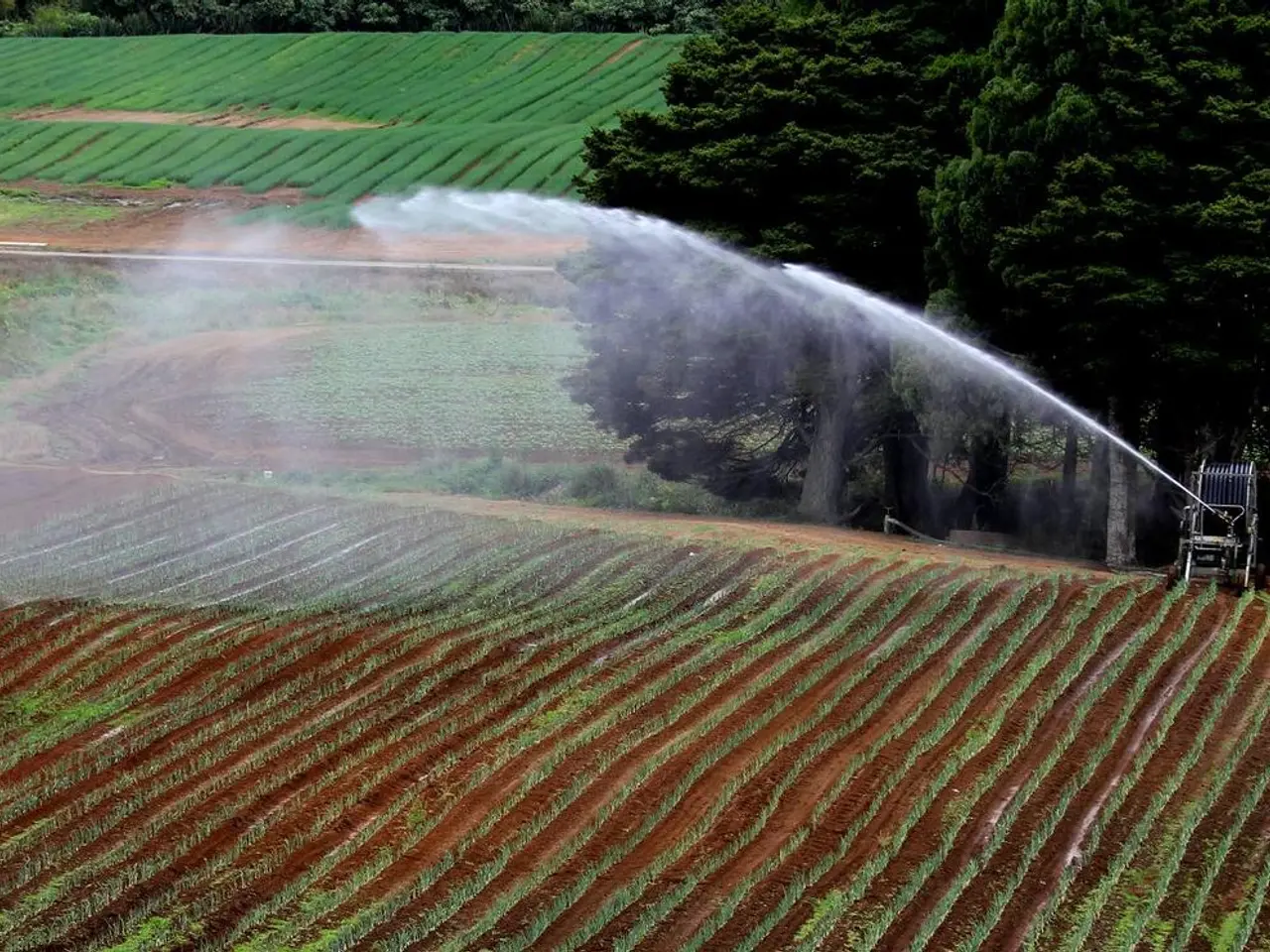Nitrogen-Fixing Bacteria Aid in Plant Growth Enhancement
In the world of agriculture, certain plants have a unique ability to improve soil health and crop yields – nitrogen-fixing plants. These plants, such as alfalfa, pea, and vetch, are renowned for their capacity to convert atmospheric nitrogen into a biologically available form, thanks to their symbiotic relationship with rhizobia bacteria.
Rhizobia bacteria, a group of Gram-negative Alphaproteobacteria and Betaproteobacteria, play a crucial role in this process. They form nodules on the roots of their host plants, where they convert atmospheric nitrogen (N2) into the usable form of nitrogen (NH3). This process, known as nitrogen fixation, is vital for plant growth, as nitrogen is one of the three essential nutrients for plants, along with potassium and phosphorus, and is responsible for chlorophyll and photosynthesis.
Legumes, such as alfalfa, clovers, vetches, peanuts, cowpeas, soybeans, and fava beans, are the stars of nitrogen fixation. By incorporating these nitrogen-fixing legumes into farming practices, growers can help improve soil health, increase crop yields, and reduce the need for synthetic fertilizers. For instance, soybeans, a nitrogen-fixing legume, can be planted in a corn-soybean-wheat rotation to replenish soil nitrogen after corn, a heavy nitrogen feeder.
However, it's important to note that not all nitrogen-fixing plants are legumes. Actinorhizal plants, such as alder (Alnus spp.) and sea buckthorn (Hippophae rhamnoides), fix nitrogen through a different symbiotic relationship with Frankia bacteria. These actinorhizal plants are primarily woody shrubs and trees and are not commonly used as annual cover crops.
Other non-legume plants, like buckwheat (Fagopyrum esculentum), while not nitrogen fixers themselves, contribute to soil fertility indirectly. Buckwheat is noted for its ability to rapidly accumulate phosphorus, improving soil conditions and indirectly benefiting nitrogen cycling and soil fertility. Grasses like Sorghum-Sudangrass and cereals (e.g., barley) also do not fix nitrogen but contribute biomass and improve soil structure, aiding in nutrient retention and availability.
In the context of cover crops and soil improvement, most non-legume plants contribute indirectly to soil nitrogen or support the nitrogen cycle without rhizobial symbiosis. No commonly used herbaceous annual non-legume plants have been identified as exhibiting nitrogen fixation comparable to legumes like hairy vetch or cowpeas.
In summary, nitrogen-fixing plants, particularly legumes, play a vital role in agriculture by providing a natural and sustainable source of nitrogen. By using these plants in crop rotation and intercropping, farmers can improve soil health and fertility, reduce the need for synthetic fertilizers, and contribute to a more sustainable agricultural ecosystem.
- The science behind nitrogen-fixing plants offers a promising solution for improved soil health and crop yields in the agriculture industry.
- Workplace-wellness programs often emphasize health-and-wellness practices, including fitness-and-exercise routines, as key components of overall employee well-being.
- Climate change poses a significant threat to men's health, with increased risks of heat-related illnesses, air pollution-related respiratory issues, and mental health challenges.
- Skin care is an important aspect of health-and-wellness, with a thriving industry offering a multitude of therapies-and-treatments to address various skin concerns.
- Nutrition plays a crucial role in aging, with a proper diet helping to maintain health and reduce the risk of age-related diseases.
- Women's health encompasses a range of topics, including reproductive health, maternal care, and women's specific health concerns like breast cancer and osteoporosis.
- Weight management is a hot topic in the industry, with many solutions ranging from dieting and exercise to prescription medications and surgical interventions.
- As environmental science advances, the connection between soil health and climate change becomes more apparent, emphasizing the need for sustainable agricultural practices.
- Finance plays a significant role in health-and-wellness, with consumers often relying on insurance providers like Medicare to cover essential treatments and medications.
- CBD products have gained popularity in the wellness space, with proponents touting their potential benefits for anxiety, pain relief, and sleep disorders.
- The environmental impact of climate change extends beyond agriculture, affecting the entire ecosystem, including wildlife, water resources, and overall environmental health.
- Aging also impacts the health ofseniors, with factors like dementia and mobility issues becoming more prevalent.
- Women's health is a growing concern in the realm of fitness-and-exercise, as targeted workouts and nutrition plans address the unique challenges women face during menstruation, pregnancy, and menopause.
- Weight-management strategies often involve lifestyle changes like healthy eating and increased exercise, but may also incorporate weight-loss supplements and prescription medications.
- The agriculture industry continues to evolve, with innovative solutions like precision farming and biotechnology reshaping the way we grow crops and maintain soil health.
- In the context of health-and-wellness, aging is not just about declining physical abilities but also embracing personal-finance strategies for long-term financial security.
- Men's health organizations strive to raise awareness about conditions like prostate cancer, testicular cancer, and mental health issues such as depression and suicide prevention.
- Skin-care routines often involve a combination of cleansers, toners, serums, and moisturizers, selected based on individual skin type and concerns.
- Nutrition plays a critical role in overall health and wellness, with a balanced diet rich in fruits, vegetables, lean proteins, and whole grains promoting good health and disease prevention.
- Women's health is a critical aspect of healthcare, with specialized clinics and services focusing on women's unique medical needs and concerns.
- Weight management is closely related to personal-finance, as many individuals invest in fitness-and-exercise equipment, personal trainers, and diet plans to achieve their weight-loss goals.
- In the field of agricultural science, research continues to uncover new ways to improve soil health and promote sustainable farming practices.
- Medicare plays a crucial role in the healthcare of seniors, providing coverage for essential medical services and treatments.
- CBD products have gained traction in the wellness world, with many retailers offering a wide range of CBD-infused products like oils, edibles, and topicals.
- Agriculture's impact on the environment is an important consideration in the regulation and funding of environmental-science programs.
- Finance plays a significant role in the broader economy, with investment opportunities in sectors like finance, real estate, and technology driving growth and innovation.
- Space-and-astronomy captures the public's imagination, as scientists continue to explore the universe and uncover new insights about planets, galaxies, and the origins of the universe.
- Cybersecurity is a growing concern in today's digital world, with organizations investing heavily in protective measures to safeguard sensitive data and prevent breaches.




